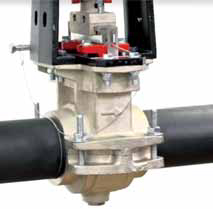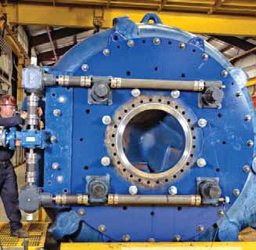
Modern sizing procedures for slurry pumps are computerized and
much easier to conduct with software tools such as Metso’s
PumpDim for Windows.
Finessing the Flow
Pumps can be too big or too small for the job, pipes can wear out quicker than expected,
and valves might not stand up to tough applications. Take advantage of the tools,
products and technologies that can help avoid most of these problems..
By Russell A. Carter, Contributing Editor

Taking the analogy a step or two further, human health depends heavily on the vascular system’s basic design and inherent efficiency, but almost as importantly on care and attention. Likewise for a mining operation’s piping, pumps and valving, good basic design, proper selection of components and regular upkeep are essential for best performance.
Programs for Pumps and Piping
Optimal performance begins with solid
system design. Among the tools available
for pump selection, pipeline design and
system simulation are programs available
both from vendors and third parties. Metso,
for example, offers PumpDim for sizing
and selecting the right models from its
pump product line. According to the company,
Microsoft Windows-based PumpDim
can size a pump for a specified duty point
or a pipe system, pumping clear water, viscous
liquids or a suspension of solids in
a liquid. When it comes to sizing pumps
for slurry applications, Metso said results
from PumpDim are representative for settling
slurries with “normal” particle size
and distribution such as those found in
mineral processing industries, with concentrations
lower than 40% by volume.
The program considers and/or calculates
the following:
• Critical flow velocity to avoid settling of
particles in pipes.
• The complete pipe head loss system
curve when static head, pipes, fittings
and other components are specified.
• Pumping of froth when a froth factor is
specified.
• Effect of solids on the generated pump
head and pump efficiency.
• Recommends material for the pump
wet end considering particle size and
distribution.
• Selects pump size for the specified duty
and calculates required pump speed.
• Calculates shaft deflection and bearing
life at the duty point.
• Recommends motor size and drive.
• Calculates slurry density based on particle
and liquid density and concentration
and/or tonnage.
• Calculates actual flow through an existing
installation based on pipe system,
slurry properties and pump speed.
FluidFlow from Flite Software can be
used to determine pressure losses and design
flow distribution systems transporting
settling slurries. Flite said the software
helps engineers eliminate the pitfalls
of spreadsheet solutions by enabling a
whole-system evaluation. The tools within
the program help users select optimum
pipe sizes and pump capacities, eliminating
the risk of incorrect line sizing which
can lead to poor system performance, energy
wastage and line blockages. FluidFlow
software has been used to model slurry
flow systems by Worley Parsons, Jacobs,
Hatch, Emirates Global Aluminum, Rusal,
BHP Billiton and others, according to the
developer. Its major features include:
• A database of fluids, pumps and equipment,
to which users can also add their
own data.
• Solids derating.
• Pump power usage.
• Simulation of variable speed pumps.
• Evaluation of impeller trimming.
• Determination of solids delivered in settling
slurry systems.
Datamine announced that the latest version (3.0) of Pumpsim, a 3D flow simulation software package developed for pipe networks, is now available. The software allows users to design, simulate and optimize pump and liquid reticulation (piping) systems. According to Datamine, it was designed to tackle the common problem of poor water reticulation design within the mining and other industrial environments, which often leads to unreliable water supply systems. This may result in insufficient water supply or pressure, pipe breakage, poor pump performance and productions delays. These problems, said Datamine, can be solved by the software as it ensures pumps and pipes are correctly sized and rated, and that pipe and pump design is optimal for all required activities.
The new release brings several improvements
claimed to make the simulation
easier and more efficient. These
include:
• 3D Containers – Any 3D shape can now
be converted to model bodies of water,
including open pits and flooded tunnels.
• Stages – Simulate the different stages
of the project in one file.
• Dynamic Simulation – Enter a sequence of
time on and off for dynamic simulation.
• Multiple Windows – Visualize different
parts of the mine.
• Contamination – Simulate contamination
spreading through the model,
and “reverse” simulate to find possible
source(s) of contamination.
• Video – Record a movie of a simulation
for convenient playback and review.
• Measuring Tool – Select a path on the
pipe network and generate a graph of
available data (i.e., pressure, flow etc.).
Control the Flow
An integral element of piping system
layout is designer cognizance that critical
pipeline segments need reliable control
mechanisms, usually in the form of
valves, that can meet the demands of
the application without incurring special
maintenance needs, unscheduled downtime
or degraded performance during
their anticipated service life. A few examples
illustrate the wide choice of products
available to handle everything from
everyday transfer of various mining-related
fluids through industrial-grade plastic
piping, to high-pressure pumping and
control of large-diameter slurry pipelines.

“The 906 KGV is an advanced technology that encloses all wear parts into a single seat cartridge kit, which reduces maintenance downtime by up to 95% and generates up to 60% savings in annual maintenance costs,” said Mike Prince, product engineer at Victaulic. “We have witnessed our KGVs lasting more than five times longer than alternative products currently on the market.” The new valve, according to the company, also improves worker safety, eliminating the necessity and subsequent risk for workers, of rigging with heavy chains and pulleys overhead.
The 906 KGV joins plain-end HDPE pipe. It is available in sizes ranging from 3 to 8 in. and rated to 150 psi (1034 kPa/10 bar), or the maximum rating of the HDPE pipe, whichever is lower. Corflex Engineering in South Africa has been building pinch valves for slurry pipeline applications since 1981. It offers units suitable for handling working pressures up to 200 bar (2,900 psi), with standard models up to 500 mm in size and 1,000 mm units available.
Corflex believes pinch valves are often the most suitable valve for slurry handling, because in the open position they resemble a rubber-lined pipe. Other types of valves, according to the company, have problems with abrasive material or pressure: Quarter-turn designs such as plug and ball valves generally have a reduced port that increases the velocity and each time they are turned they are scratched and end up leaking. Knife gates often have blades that are thinner than blank flanges for the same pressure and at high pressure can leak or form dished ends.
Recently, the company filled an order for 450-mm pinch valves to operate at a pressure of 25 bar for a tailings project at a mine in South Africa. Corflex said that pinch valves used for high-pressure applications have to be built with both safety and performance in mind –— the force required to close and seal a 450-mm pinch valve at 25 bar, for example, is 77 tons. To build a 450-mm product suitable for 25 bar applications, a special valve had to be designed and built that, in every respect, was similar to Corflex’s 500-mm high-pressure pinch valve. The 450-mm pinch valve sleeve developed to handle such high pressures required the design of special tooling and needed the addition of larger-gauge wire reinforcement in the flange area. The tooling development work enabled the company to build a 450-mm pinch valve for a working pressure up to 35 bar, a test pressure of 70 bar and a calculated burst of 105 bar. The 450-mm valves are fitted with 4 x 160-mm hydraulic cylinders, which, at a hydraulic pressure of 200 bar, would seal the valves against a pressure of 34 bar, providing a sealing safety factor in excess of 30%.
The hydraulic power pack to operate the valves has a constant recharge system to ensure the valves stay closed and do not creep open. Although not required for this project, the hydraulic power pack could have been built to automatically close the pinch valves in the event of an electrical power failure, which means the valves could be used as open/close or nonreturn valves. According to Corflex, typical nonreturn valves in slurry pipelines are not always reliable so this system offers significant advantages.
Automated Adjustments Save Time
Efficient pump operation in aggressive
wear applications depends on thorough
and precise weekly
maintenance. A
common maintenance
procedure for
large centrifugal cyclone
feed pumps,
for example, involves
adjusting the
internal clearance
between the pump
impeller nose gap
and the suction liner
— a task that’s
usually done manually.
As mineral
producers strive to
cut operational and
maintenance costs,
sometimes the next
best thing to reducing
or eliminating
periodic mandatory
maintenance on
pumps is to simply
remove the need to
have a worker, or a crew, present during a
maintenance procedure.

Perry said GIW evaluated different options for the RAMSL, but finally decided to base the design on mechanical components in order to provide a more robust product with easy maintenance features and high operation reliability. “Other options were evaluated such as a hydraulic or pneumatic design, but all of them required more complex configurations adding potential points of failure and demanding more maintenance time by the end-user. “The RAMSL user interface serves as both the control panel for the operation of the unit and as an output source for critical data taken from the pump, such as real-time vibration readings and precise movements of the suction liner (to within 0.01 mm),” he explained.
This product enhancement carries two primary benefits: ease of maintenance and more efficient use of time and resources. “Both benefits stem from the ability to adjust the equipment against roughly 400,000 pounds of force from a safe distance without exerting more effort than it takes to press a button on a touchscreen,” said Perry. Peripheral benefits include the ability to match maintenance schedules to best suit the needs of each pump installation, and RAMSL can also help minimize the potential for equipment damage due to over-adjustments caused by using traditional methods.
And, there are long-term technology benefits associated with the project as well. “We are beginning to see how the collaboration of RAMSL with the internet of things (IoT) to collect and analyze data can benefit our customers in the area of predictive maintenance and inventory planning,” explained Diwakar Aduri, GIW product development manager.